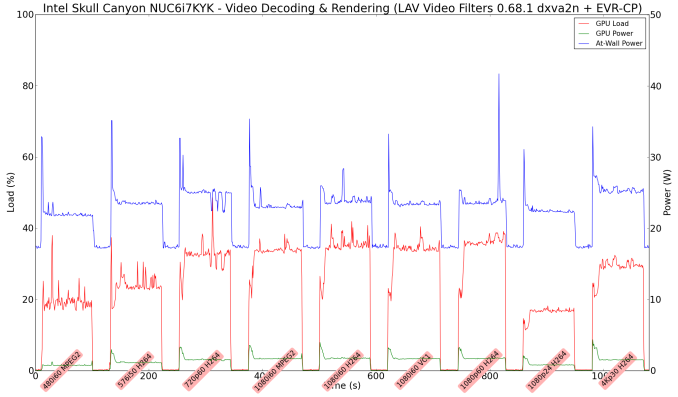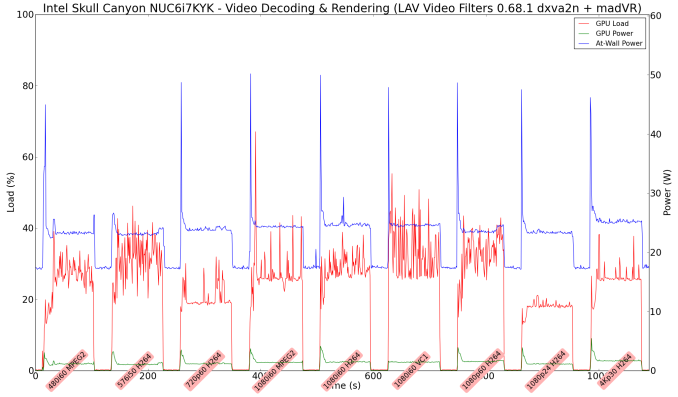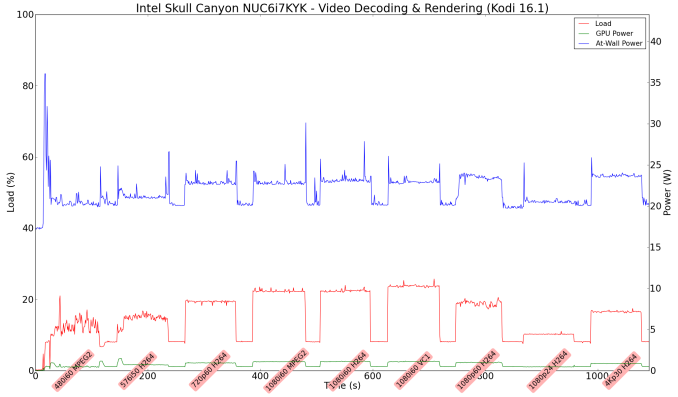The Intel Skull Canyon NUC6i7KYK mini-PC Review
by Ganesh T S on May 23, 2016 8:00 AM ESTHTPC Credentials
The higher TDP of the processor in Skull Canyon, combined with the new chassis design, makes the unit end up with a bit more noise compared to the traditional NUCs. It would be tempting to say that the extra EUs in the Iris Pro Graphics 580, combined with the eDRAM, would make GPU-intensive renderers such as madVR operate more effectively. That could be a bit true in part (though, madVR now has a DXVA2 option for certain scaling operations), but, the GPU still doesn't have full HEVC 10b decoding, or stable drivers for HEVC decoding on WIndows 10. In any case, it is still worthwhile to evaluate basic HTPC capabilities of the Skull Canyon NUC6i7KYK.
Refresh Rate Accurancy
Starting with Haswell, Intel, AMD and NVIDIA have been on par with respect to display refresh rate accuracy. The most important refresh rate for videophiles is obviously 23.976 Hz (the 23 Hz setting). As expected, the Intel NUC6i7KYK (Skull Canyon) has no trouble with refreshing the display appropriately in this setting.
The gallery below presents some of the other refresh rates that we tested out. The first statistic in madVR's OSD indicates the display refresh rate.
Network Streaming Efficiency
Evaluation of OTT playback efficiency was done by playing back our standard YouTube test stream and five minutes from our standard Netflix test title. Using HTML5, the YouTube stream plays back a 1080p H.264 encoding. Since YouTube now defaults to HTML5 for video playback, we have stopped evaluating Adobe Flash acceleration. Note that only NVIDIA exposes GPU and VPU loads separately. Both Intel and AMD bundle the decoder load along with the GPU load. The following two graphs show the power consumption at the wall for playback of the HTML5 stream in Mozilla Firefox (v 46.0.1).

GPU load was around 13.71% for the YouTube HTML5 stream and 0.02% for the steady state 6 Mbps Netflix streaming case. The power consumption of the GPU block was reported to be 0.71W for the YouTube HTML5 stream and 0.13W for Netflix.
Netflix streaming evaluation was done using the Windows 10 Netflix app. Manual stream selection is available (Ctrl-Alt-Shift-S) and debug information / statistics can also be viewed (Ctrl-Alt-Shift-D). Statistics collected for the YouTube streaming experiment were also collected here.

Decoding and Rendering Benchmarks
In order to evaluate local file playback, we concentrate on EVR-CP, madVR and Kodi. We already know that EVR works quite well even with the Intel IGP for our test streams. Under madVR, we used the DXVA2 scaling logic (as Intel's fixed-function scaling logic triggered via DXVA2 APIs is known to be quite effective). We used MPC-HC 1.7.10 x86 with LAV Filters 0.68.1 set as preferred in the options. In the second part, we used madVR 0.90.19.
In our earlier reviews, we focused on presenting the GPU loading and power consumption at the wall in a table (with problematic streams in bold). Starting with the Broadwell NUC review, we decided to represent the GPU load and power consumption in a graph with dual Y-axes. Nine different test streams of 90 seconds each were played back with a gap of 30 seconds between each of them. The characteristics of each stream are annotated at the bottom of the graph. Note that the GPU usage is graphed in red and needs to be considered against the left axis, while the at-wall power consumption is graphed in green and needs to be considered against the right axis.
Frame drops are evident whenever the GPU load consistently stays above the 85 - 90% mark. We did not hit that case with any of our test streams. Note that we have not moved to 4K officially for our HTPC evaluation. We did check out that HEVC 8b decoding works well (even 4Kp60 had no issues), but HEVC 10b hybrid decoding was a bit of a mess - some clips worked OK with heavy CPU usage, while other clips tended to result in a black screen (those clips didn't have any issues with playback using a GTX 1080).
Moving on to the codec support, the Intel Iris Pro Graphics 580 is a known quantity with respect to the scope of supported hardware accelerated codecs. DXVA Checker serves as a confirmation for the features available in driver version 15.40.23.4444.
It must be remembered that the HEVC_VLD_Main10 DXVA profile noted above utilizes hybrid decoding with both CPU and GPU resources getting taxed.
On a generic note, while playing back 4K videos on a 1080p display, I noted that madVR with DXVA2 scaling was more power-efficient compared to using the EVR-CP renderer that MPC-HC uses by default.




















133 Comments
View All Comments
spikebike - Monday, May 23, 2016 - link
Anyone know why the GB-BXi5G-760 is so slow? The spec looks pretty similar to the EN970 (same gpu), to performs radically worse on all the games.Calista - Monday, May 23, 2016 - link
Was it not related to heavy throttling? Like *really heavy* throttling.trane - Tuesday, May 24, 2016 - link
Pleasantly surprised by the GPU. Pretty damn good, around the same as a 750 Ti.tipoo - Wednesday, May 25, 2016 - link
I thought it would be more to be honest. Looks like the size of the heatsink is limiting it. It's good, but at nearly double the EUs of the already ok Iris Pro 5200 in my Haswell machine, I expected the 72 EU to do better than this.potf - Tuesday, May 24, 2016 - link
Missing Noise levels in anandtech reviews, with the thermals ?The product maybe has a target, which is not me, but the problem with the mini pc reviews at anand is that we only get 1 or 2 little measurements on the fan noise, and in the skull canyon Nuc, I think it's disappointing, as you mention it in the final comment
> " We would gladly trade a modest increase in the footprint of the system for lower fan noise. That said, the fan noise is in no way comparable to the BRIX Gaming lineup. It is just that it is not as silent as the traditional NUCs."
For example, measuring noise at idle, at gpu / cpu loads, and getting a noise comparison at these points would be useful : the thermals are very nice, but you cannot compare them really/easily from one pc to the other.
My point is that with the current idle power at 17 watts in your test, this racehorse nuc is never ever silent or even quiet, but I would like to see comparisons with the other nucs or at least the MSI cubi 2 recently reviewed.
Also curious about the noise level of the asus VC65 / VC65R relative to that of the Skull Nuc ;), what I mean is that the chosen form factor can be either optimal, or poorer than other 35W-45W solutions.
Will we be getting noise comparisons betwen PCs in a nice chart soon ?
Osamede - Tuesday, May 24, 2016 - link
I'm asking: what is the use case that Intel are targeting and marketing to? Is it 1080P?milkod2001 - Tuesday, May 24, 2016 - link
I'd say the only NUCs which make sense to buy are the cheapest options(not the one reviewed here). Good enough for office work, youtube, Facebook and internet browsing.For gaming or serious work laptop or mini ATX build will give user much much more than this overpriced fancy NUC
rhx123 - Tuesday, May 24, 2016 - link
So disappointed. I was really looking forward to this product, but the PCIE/DMI Situation is incredibly silly. Must be intentional, but why?Such a waste.
Femton - Tuesday, May 24, 2016 - link
What is your comment to jasonelmore who earlier ( Monday, May 23, 2016) that "it will work fine. Intel has been using the Razer External GPU Chassis and they even commented on it here on Anandtech Comments, on the last article that was posted about it. DMI 3.0 still does 4GB/s and the CPU is not transferring huge amounts of bandwidth hungry texture data back and forth with the CPU." ?Osamede - Tuesday, May 24, 2016 - link
Noise focus is something that has been a weakness here for some time. And not much awareness from the folks who run this place about it.SPCR is a better place to find what you are asking about. Intel is one of their sponsors, so no doubt they'll have a review up before long.